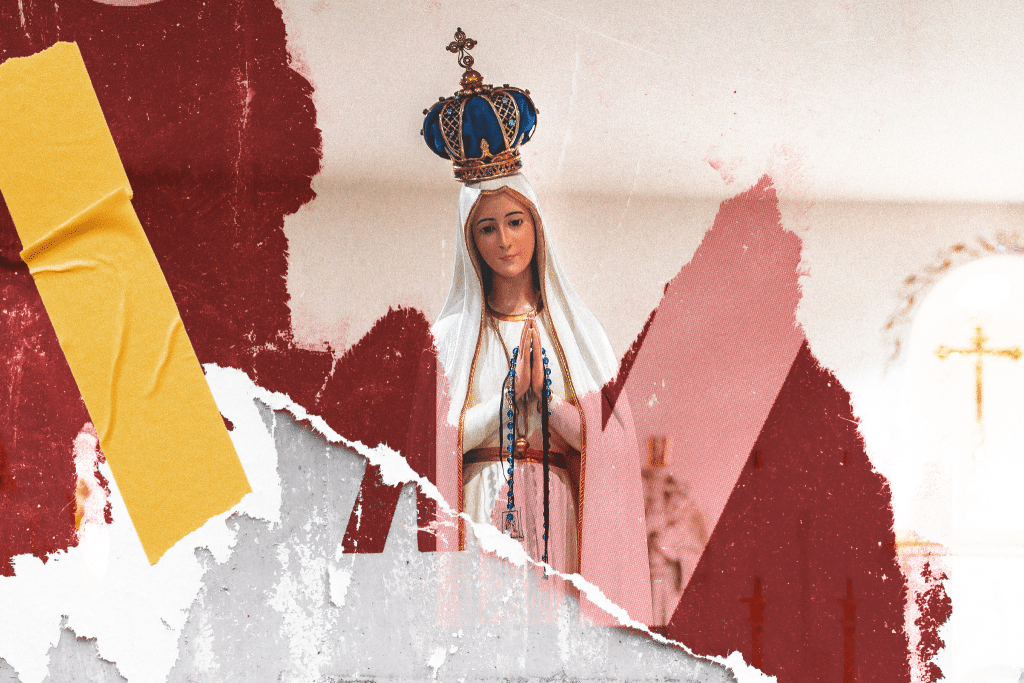Yes, it’s getting colder—meaning it’s a good time to look forward to spring, when the “sweet breath of April,” as Chaucer writes in “Canterbury Tales,” moves the heart to “long to go on pilgrimages.”
Here is a whirlwind tour of seven Detroit area shrines to help inspire that longing for holy travel. Consider beginning your travels even now. All seven shrines welcome pilgrims any time of year, but check for times/days of opening and Covid-19 restrictions.
Buen Camino!—Have a good journey.
Holy house of Riverview – Our Lady of Fatima Chapel
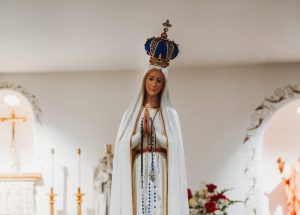
It is one of the archdiocese’s lesser-known pilgrimage sites, but that is about to change.
Our Lady of Fatima Chapel in Riverview became an archdiocesan-endorsed shrine on October 13, when Bishop Gerald Battersby read the decree from Archbishop Allen Vigneron during Mass at the shrine. The date is significant. On October 13, 1917, Our Lady confirmed her appearances to the three shepherd children of Fatima through a miraculous spinning of the sun.
The shrine’s Detroit roots reach back to 1955 when members of the Blue Army of Fatima (now the Word Apostolate of Fatima) opened an evangelization center at St. Andrew Parish. The apostolate’s mission: to encourage praying the rosary, practicing the First Friday and First Saturday devotions, and offering up one’s struggles for the conversion of hearts.
Pilgrims have been drawn to the shrine’s Riverview location since 2006. The chapel includes a life-sized statue of Our Lady of Fatima and a reliquary holding a sliver tree upon which Our Lady appeared. There is a superbly stocked bookstore and a meeting hall.
“My desire is for pilgrims to receive the same joy and blessings that pilgrims who visit Fatima each year experience,” says Leonard St. Pierre, volunteer apostolate president. Spiritual director Father John Hedges believes it is providential that recognition happened during the Jubilee Year of the Holy House of Loreto.
“Our Lady of Fatima Shrine is a ‘holy house’ of prayer, penance and Eucharistic adoration,” Father expressed recently. “This is the time to make our homes ‘replicas’ of the holy house of Jesus, Mary and Joseph.”
A foretaste of heaven – St. Joseph Shrine
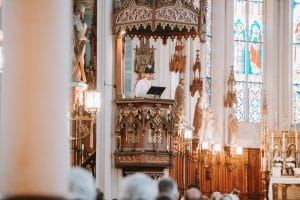
The spire of St. Joseph Shrine juts 200 feet into the Detroit skyline. The spiritual landmark near Eastern Market is even more stunning now that it has been restored to historically-accurate splendor.
The Gothic Revival shrine beneath the spire is equally splendid—as is the Traditional Latin Mass celebrated daily by the canons (priests) of the Institute of Christ the King.
“We have a beautiful spiritual reality and a physical reality that draws hearts to St. Joseph parish and shrine,” says Canon Michael Stein, rector of the shrine. The charism of his community, he says, is “bringing the sacred back into the world.”
In 2016, Archbishop Vigneron invited the Institute to oversee the parish and care for the historic 1873 building. The canons immediately began to rehabilitate the church structure and preserve its artistic treasures. These treasures include stained glass windows designated “of national importance” by the National Register of Historic Places.
“I would encourage pilgrims to allow for that first moment of wonder when they enter the shrine,” Canon Stein suggests. “Allow the awe of God’s house to seize you, like a foretaste of the beatific vision.”
The Institute has rejuvenated the spiritual life of St. Joseph Parish, as well. Membership has grown to 220 families attracted to liturgies and sacraments all celebrated in the Traditional Latin rite.
The archbishop rewarded the Institute of Christ the King by elevating St. Joseph to an archdiocesan shrine in March 2020. Shrine doors are open an extraordinary 14 hours daily. Call first for a guided tour.
Franciscan worker of wonders – Solanus Casey Center
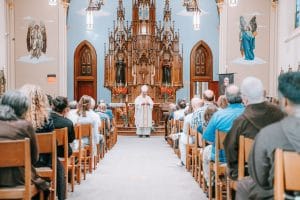
Archbishop Vigneron ends his pastoral letter, Unleash the Gospel,by calling upon a special “companion” for support. That companion is Blessed Solanus Casey, the Capuchin Franciscan who was beatified the same year, 2017, as the release of the letter. A “providential sign,” writes the archbishop.
We are fortunate the shrine of Blessed Solanus is here in Detroit, along with his holy remains. The Solanus Casey Center at St. Bonaventure monastery is possibly the most professionally designed Catholic shrine in the country.
Pilgrims enter through a landscaped Creation Garden that illustrates St. Francis’s poem Canticle of Creatures. Cathy, a parishioner of Our Lady of the Woods Parish, is spending part of her Sunday visiting the monastery. “I stop here when I am in the area because the church is always open. I know I have somewhere to come and worship.”
Cathy is an emissary for her family today, placing their petitions before the tomb of Blessed Solanus. She lights a candle before an image of Our Lady of Fatima in the Creation Garden and kneels for a short prayer before returning home.
Pilgrims experience Franciscan spirituality by “meeting” individuals who exemplify the Beatitudes, such as St. Oscar Romero, through their life-sized statues. An exhibit hall chronicles the life of Blessed Solanus through personal artifacts such as his violin—and travel trunk made by outlaw Cole Younger!
Visitors ultimately reach a sacred space: the crypt of Blessed Solanus. The casket of this wonderworker of healing is visible through a glass dome. A bookstore and dining hall add to the pilgrimage experience at this Franciscan holy house.
Home of a future saint? – Basilica and Shrine of Ste. Anne de Detroit
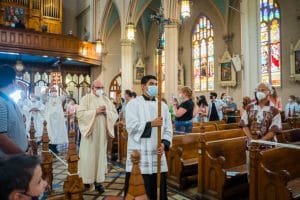
When Joseph Moss says a pilgrimage to the basilica of Ste. Anne is like “stepping into history,” he is not exaggerating. “You feel the 300-plus years of history,” says the basilica’s music director. “It permeates the building.”
Walk through the doors of the basilica and enter a parish that extends back 319 years. The first Ste. Anne dates from July 26, 1701, two days after the founding of Detroit. The current structure, the parish’s eighth, was consecrated in 1887.
The magnificent French neo-Gothic basilica—with its pointed arches and star spangle vaulted ceiling—is nationally important as the resting place of Father Gabriel Richard. The pioneer priest pastored the parish from 1802 until 1832 when he died ministering to cholera victims. His secular accomplishments, such as serving in the U.S. Congress, are surpassed only by his spiritual deeds. Pilgrims honor Father Richard’s memory by visiting a chapel where his remains lie in his original wooden casket.
The shrine of Ste. Anne, mother of the Blessed Virgin, is left of the sanctuary. Visitors venerate her first class relic and admire the precious statue of Ste. Anne lovingly embracing her daughter.
The shrine is renowned as a place of “miracles” for those praying for the gift of children. “It’s really remarkable,” Moss relates. “We have many stories of couples who come back a few months later and tell us they are expecting.”
Someday pilgrims may honor Father Richard as a saint. Msgr. Charles Kosanke, Ste. Anne’s pastor, is establishing a guild to document Father’s “heroic virtues” to support the case for canonization.
A “prayed-in” place – Assumption Grotto Shrine
Blue sky and a breeze warmed by pure sunlight. A fine morning for attending a late-September Mass at Assumption Grotto Parish, and for visiting the only outdoor pilgrimage site on our list of seven.
The Gratiot Avenue parish, founded in 1832, is the archdiocese’s second oldest. The shrine dates to 1881, after the parish pastor made a pilgrimage to Lourdes, France, and pledged to build a replica of its grotto on the parish grounds.
Pilgrims approach the shrine by a dramatic 100-feet-long walkway. The approach evokes a promenade in a park of a European city—except this park is a meticulously landscaped parish cemetery.
The shrine is in the form of an arched alcove, suggesting the grotto at Lourdes. Against the rear wall is a statue of the Blessed Virgin as the Immaculate Conception. A bronze statue of St. Bernadette of Lourdes kneels near a running pool surrounded by roses.
Visiting the cemetery after Mass is a longstanding custom. Today is no exception, as children run among the monuments while adults stroll the promenade.
The cemetery “is a very ‘prayed-in’ place,” offers Natalie, a lively woman in her 70s. She recommends visiting on August 15, the feast of the Assumption, when there is a healing service. Larry Stump suggests attending the feast day’s spectacular evening Mass when parishioners “process to the grotto holding lighted candles as they do at Lourdes.”
“There have been miracles worked here,” offers Charles, a young adult carrying a red missal. “The grotto helps you to realize the importance of God in your life, not just the material things.”
Masterwork of art, beacon of light – National Shrine of the Little Flower Basilica
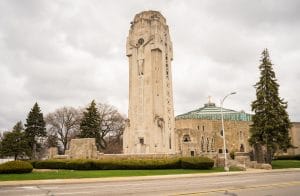
It is a happy coincidence. It happens to be the feast day of St. Therese of Lisieux, October 1, when I visit the National Shrine of the Little Flower Basilica in Royal Oak. A pilgrim could spend days exploring this Art Deco masterwork.
Pastor Father Joseph Horn sums up St. Therese’s “little way” of holiness: “St. Therese said if she were a part of the mystical body of Christ, she would be the heart, because she wanted to be the love of the Father for the people of God. We want to welcome pilgrims with love, to be the heart of love for the mystical body of Christ.”
The church-in-the-round interior seats an incredible 3,000 worshippers. Suspended above the altar is a gigantic oak canopy lit from within, making its stained glass panels seem to be on fire.
Side chapels are adorned with painted murals. Statuaries and plaques are designed by legendary Detroit sculptor Corrado Parducci. Pilgrims should seek out the Martin Room, with its relics of St. Therese’s parents, Sts. Louis and Zelie Martin.
The shrine’s limestone tower with a relief of the crucified Christ is lit up at night, “testifying to our Christian faith,” explains Christine Renner, shrine marketing director. “The beacon of light draws you into the shrine. It’s pretty amazing.”
Carmen Scofield is making a visit to the shrine today, accompanied by Orchard Lake seminarian Przemek Rozestwinski. Why does she come so often? “Because I love St. Therese!” she says. “You feel holy when you come here.”
My next stop happens to be the Orchard Lake’s chapel. Przemek offers to be my guide. Another happy coincidence.
Polish pride and reverence – Shrine of St. John Paul II
St. Cyril & Methodius Seminary of Orchard Lake Schools trains seminarians from Poland to minister in the United States. Gazing up at the façade of Our Lady of Orchard Lake Chapel, Poland’s love for the Blessed Mother could not be clearer. Suspended above the entrance is a 25-feet-high copper plated image of the Queen of Heaven. Inside the chapel is a shrine to another great love of Poland, St. John Paul II.
My first thought: “What is a kayak doing in the vestibule?” On his visit to Orchard Lake Schools in 1976 as Cardinal Karol Wojtyla, John Paul II rowed this kayak on Orchard Lake.
“The kayak is a sacred second-class relic,” seminarian Przemek Rozestwinski explains, then laughs, “You could say, so is Orchard Lake!”
The Shrine of St. John Paul II flanks the chapel’s sanctuary, where pilgrims venerate the saint’s first-class relic. Another artifact of reverence is a glittering image of Our Lady of Czestochowa that John Paul II gifted to Orchard Lake.
The seminary is raising funds for a matching side chapel dedicated to St. Faustina Kowalska, the Polish nun and missionary of Jesus’ Divine Mercy. A first-class relic of St. Faustina—a piece of bone—has just been obtained from St. Faustina’s community in Lithuania.
Pilgrims who wander the campus will discover the grotto of Our Lady of Lourdes near the lake, and a memorial to the Poles murdered by the Red Army at Katyn Forest after World War II.
“A candle burns at the memorial every day. It is a place,” Przemek says softly, “which is very dear to us.”
I sit before the shrine of St. John Paul II and realize how my whirlwind pilgrimage has come full circle. The shrine’s reliquary holds a piece of cloth saturated in the saint’s blood. I think of how an assassin’s bullet nearly killed John Paul II in 1981.
Then I recall how he credited Our Lady of Fatima for deflecting the bullet and saving his life. A replica of that statue is the crowning image at Our Lady of Fatima Chapel, the first stop on this journey.
Consider visiting the holy houses of the Archdiocese of Detroit. May the words of St. John Paul II come true for us all: “How many people have gone to a shrine out of curiosity—and have returned transformed!”
For more information about these shrines, visit unleashthegospel.org to read the extended article.
